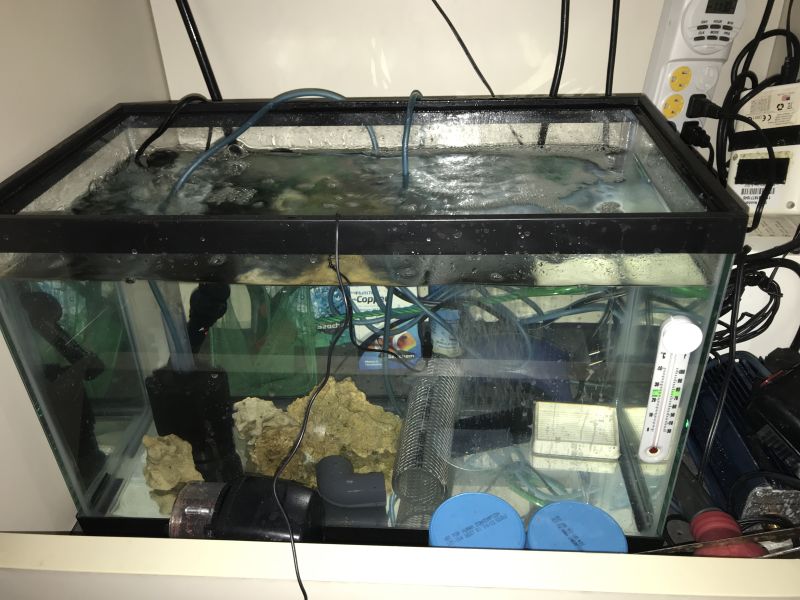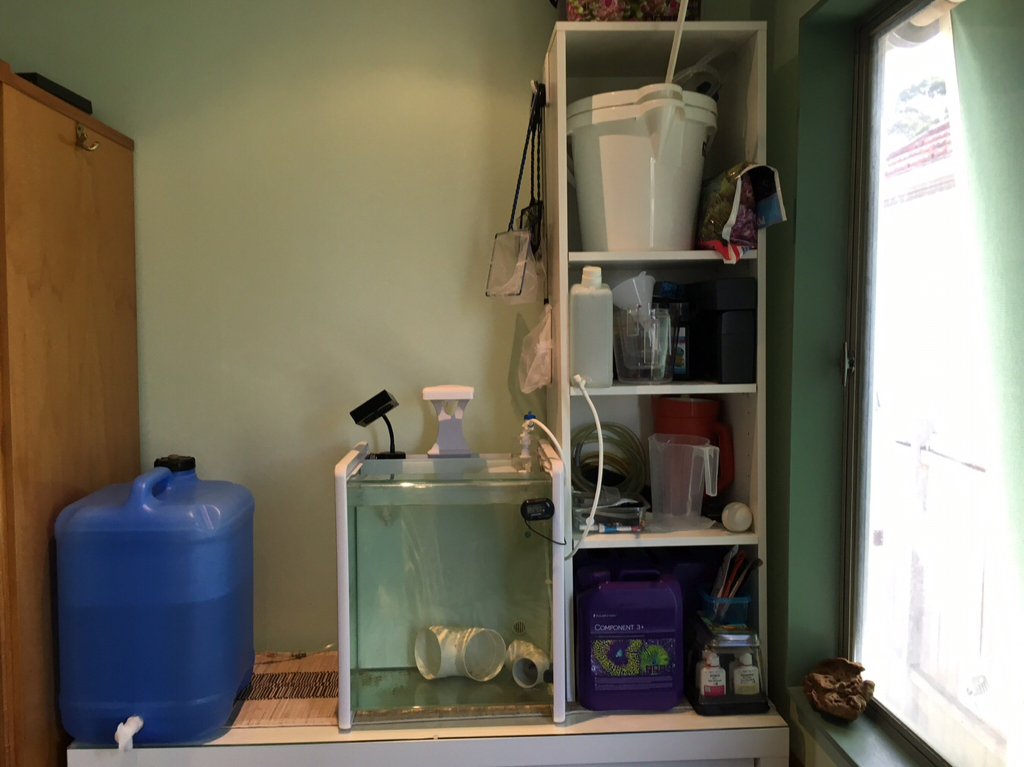jonnybravo22
New member
Hey all,
I had a parasite wipe out my tank last year and have decided to QT everything from now on. I've been reefing for something like 12 years and until recently haven't really had a problem keeping most fish alive (SPS is another story). I've even bred clownfish and successfully raised the fry.
But I've never done a QT tank before. I recently got some anthias fish and they didn't last 24 hours in my QT setup. It's very disheartening and embarrassing, and I guess I need help.
My setup is shown here:

1. 10G standard tank, wiped down with water and paper towels (but not vinegar) before use
2. 50W Heater
3. Sponge filter
4. Airstone (added later)
5. PVC elbow and tubing to hide in
6. Live rock (added later from the sump of my 3+ year old setup)
7. Rubber pad which was holding another pump before that was removed
Attempt: 3 small bartlett's anthias.
I drip acclimated for an hour, matched QT salinity to shipping water salinity (1.015); I used new saltwater water to fill the 10g; bath in methlyne blue for 45 minutes in a 5g bucket and put into QT;
Things I know I did wrong:
1. bad heater creating awful temperature swings
2. probably should have used bleach/vinegar to clean the tank initially
What happened:
They were happy and healthy, breathing normally up until the point where I put them into the QT. After a few hours I could see they were breathing heavily. I checked the temp and it was a ridiculous 85 degrees instead of 77, so my heater was bad. I tried another one, also was bad (stayed on in high temp water) so I unplugged it to let the temp come down; At the same time I checked ammonia and it was at 0.25ppm on API so I did a 25% water change and grab some Live rock from my main sump hoping it can drop the ammonia levels. I check back in a few hours and it's still 0.25ppm ammonia. Temp has dropped to 72 with no heater, fish are breathing heavily, and at this point I'm freaking out.
All this was happening overnight, so no stores are open. Fearing ammonia is the cause, I grab the fish, put them back in the 5g bucket warmed to temp (77) with all newly mixed water from my reservoir (mixed a day ago) and add some methylene blue for the purpose of reducing stress and making oxygen more available (or so I've heard about this product).
When 9am comes I run to the nearest pet store and get a working heater, and an airstone to add to the sponge filter, thinking that maybe the filter alone isn't enough gas exchange. I also get Amguard to at least stabilize the ammonia situation / render it non-toxic until I can figure this out.
When I get back I added the airstone, Amguard and working heater to the QT, and once temp was at 77 I moved the fish back. Only 1 was still alive at this point. It was breathing more rapidly than any fish I'd ever seen and a few hours later was unfortunately dead.
This is a huge setback and very unfortunate, and rather than throw my hands up and say who knows what happened, I'm trying to learn what can be done so this goes better next time.
I know the temp swings were not helpful. Don't know if that alone would kill a fish in 24 hours but coupled with any ammonia maybe. Particularly at high temps.
But ammonia should have been 0. I don't know why ammonia registered in the tank so quickly. my makeup water tests 0 as does my display tank.
Questions:
1. Is it possible for 3 small bartlett's to produce .25ppm in a 10g in only 3 or 4 hours? I know they have high metabolisms but...
2. If that's the case I don't know how you would ever medicate a QT because any medication that kills nitrifying bacteria (copper, methylene blue, etc.) will make it so the only ammonia reduction comes from water changes, and that would be impossible to keep up with if you get up to 0.25ppm every 4 hours. I'd be doing water changes every hour to keep it undetectable.
3. Am I missing something here?
I appreciate your thoughts.
I had a parasite wipe out my tank last year and have decided to QT everything from now on. I've been reefing for something like 12 years and until recently haven't really had a problem keeping most fish alive (SPS is another story). I've even bred clownfish and successfully raised the fry.
But I've never done a QT tank before. I recently got some anthias fish and they didn't last 24 hours in my QT setup. It's very disheartening and embarrassing, and I guess I need help.
My setup is shown here:

1. 10G standard tank, wiped down with water and paper towels (but not vinegar) before use
2. 50W Heater
3. Sponge filter
4. Airstone (added later)
5. PVC elbow and tubing to hide in
6. Live rock (added later from the sump of my 3+ year old setup)
7. Rubber pad which was holding another pump before that was removed
Attempt: 3 small bartlett's anthias.
I drip acclimated for an hour, matched QT salinity to shipping water salinity (1.015); I used new saltwater water to fill the 10g; bath in methlyne blue for 45 minutes in a 5g bucket and put into QT;
Things I know I did wrong:
1. bad heater creating awful temperature swings
2. probably should have used bleach/vinegar to clean the tank initially
What happened:
They were happy and healthy, breathing normally up until the point where I put them into the QT. After a few hours I could see they were breathing heavily. I checked the temp and it was a ridiculous 85 degrees instead of 77, so my heater was bad. I tried another one, also was bad (stayed on in high temp water) so I unplugged it to let the temp come down; At the same time I checked ammonia and it was at 0.25ppm on API so I did a 25% water change and grab some Live rock from my main sump hoping it can drop the ammonia levels. I check back in a few hours and it's still 0.25ppm ammonia. Temp has dropped to 72 with no heater, fish are breathing heavily, and at this point I'm freaking out.
All this was happening overnight, so no stores are open. Fearing ammonia is the cause, I grab the fish, put them back in the 5g bucket warmed to temp (77) with all newly mixed water from my reservoir (mixed a day ago) and add some methylene blue for the purpose of reducing stress and making oxygen more available (or so I've heard about this product).
When 9am comes I run to the nearest pet store and get a working heater, and an airstone to add to the sponge filter, thinking that maybe the filter alone isn't enough gas exchange. I also get Amguard to at least stabilize the ammonia situation / render it non-toxic until I can figure this out.
When I get back I added the airstone, Amguard and working heater to the QT, and once temp was at 77 I moved the fish back. Only 1 was still alive at this point. It was breathing more rapidly than any fish I'd ever seen and a few hours later was unfortunately dead.
This is a huge setback and very unfortunate, and rather than throw my hands up and say who knows what happened, I'm trying to learn what can be done so this goes better next time.
I know the temp swings were not helpful. Don't know if that alone would kill a fish in 24 hours but coupled with any ammonia maybe. Particularly at high temps.
But ammonia should have been 0. I don't know why ammonia registered in the tank so quickly. my makeup water tests 0 as does my display tank.
Questions:
1. Is it possible for 3 small bartlett's to produce .25ppm in a 10g in only 3 or 4 hours? I know they have high metabolisms but...
2. If that's the case I don't know how you would ever medicate a QT because any medication that kills nitrifying bacteria (copper, methylene blue, etc.) will make it so the only ammonia reduction comes from water changes, and that would be impossible to keep up with if you get up to 0.25ppm every 4 hours. I'd be doing water changes every hour to keep it undetectable.
3. Am I missing something here?
I appreciate your thoughts.

